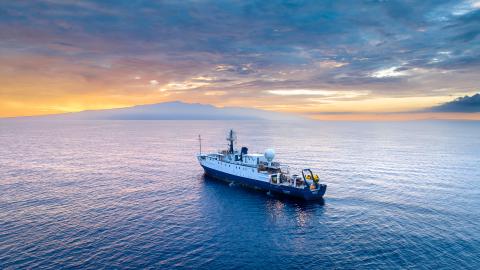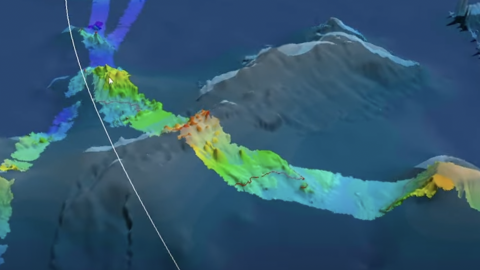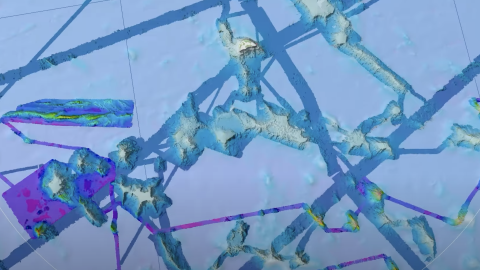Exploring the Seafloor with Mapping Intern Elijah Logan
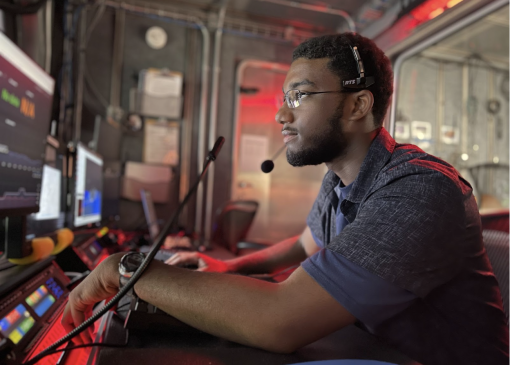
Elijah Logan joins Nautilus as part of the inaugural Tuskegee University Ocean Explorer Internship
OET is proud to welcome Elijah Logan to the Corps of Exploration as part of the inaugural student cohort in the Ocean Explorer Internship Program led by Tuskegee University and the University of Southern Mississippi. This internship program supports Tuskegee students in building professional experience and exploring STEM-related careers that connect to research themes like robotics, ocean science, education, and exploration. Logan spent 24 days aboard E/V Nautilus as a seafloor mapping intern characterizing deep-sea features near Johnston Atoll, one of the most remote regions on the planet.
As an undergraduate student at Tuskegee University in Alabama, Logan studies the human body and how medicine can expedite recovery as people age or recover from an accident. While the academic field of pre-medicine may seem like an unconventional path to the deep sea, Logan is proof that curiosity, keen interest, and an eye for science is often the first step in exploring the ocean. He says, “You just have to be willing to take the plunge.”
We sat with Logan to learn more about his experience at sea and the path that led him to Nautilus.
As a pre-med major, what brought you to the Tuskegee Ocean Exploration Club and an ocean exploration internship?
I needed something to do. At Tuskegee University, amid COVID restrictions, my options for finding something to spend my time on were very limited. I had heard about an ocean science club at the university and figured that since I had spent a lot of time on boats growing up and developed an appreciation for water, an internship at-sea might be something I’d enjoy. So, I joined and checked out a couple of meetings throughout the year. I met some other people in the club and had a good time learning more about the oceanTowards the end of the year, the Ocean Explorer Internship Program opened applications for internship opportunities with Cooperative Institute sites around the country, onshore and at-sea. I told myself, “I’ve got nothing planned for this summer. Why not try this out?” I was interested in several different ocean-related opportunities, one of which happened to be an open slot to explore the field of seafloor mapping, which was totally new to me. This led me to a multi-part internship on E/V Nautilus mapping the deep ocean floor near Johnston Atoll and continuing this summer working in a mapping data research group and a deep sea biology group at the University of Southern Mississippi.
What were you hoping to gain from the experience?
Experience in a unique work environment. Most people might never see the ocean beyond a beach, much less find themselves in the middle of it. This internship was an opportunity to get an idea of what the greater world actually looks like: open water as far as the eye can see.
What have you learned that has surprised you?
The sheer amount of seafloor that has remained unmapped for decades. I knew that humanity knows more about space than our oceans, but I didn’t realize that we had barely put a dent into learning something as basic as the layout of the seafloor. Even with satellite data, the bathymetry data seafloor mappers provide can vary wildly from what we think we know. Learning this, I see the value behind expeditions such as this one, where taking a detailed look can open up new possibilities concerning investigations into what lies below.
What have you learned about the ocean that you will carry with you after this internship?
DO NOT UNDERESTIMATE WAVES. While we were lucky enough to avoid any storms, living in the open Central Pacific means wind speeds can still get pretty high. This can result in very turbulent waves that can shake and jostle the ship. On several occasions, I was caught mid-step when the boat shifted, leaving me off balance — and against a wall on some occasions. If you are a person that typically gets seasick, make sure to travel prepared because there will definitely be some bumps along the way.
How has this experience influenced your ideas about what’s next in your career path?
This experience really cemented that I want an actively adapting and diverse career. Every day aboard a ship feels like a fine balance of “back to the old grind” with skills I was gaining confidence with and “oh, here’s something new you could do” to keep growing. Even on days without changes in our planned survey region, the workload felt balanced enough to keep things interesting. Even the internship experience of traveling and flying out to Hawai’i was a big professional change of pace I didn’t expect. While I recognize Hawaiʻi may be out of the norm to be flown around for work, having opportunities to travel for work is now something I will look into as an option for my future career choices.
What advice would you share with other students discovering an interest in a career in the ocean?
Give it a try if an opportunity comes your way. Plenty of fields and career paths run alongside research or work that need to be done in the ocean. Finding the right opportunity will put you on the right path to pursuing a career in the ocean sciences. It really doesn’t matter where you come from or what you are currently doing. Putting yourself in the right place will allow you to apply your skills. You just have to be willing to take the plunge.
The Ocean Explorer Internship Program is supported by NOAA Ocean Exploration via the Ocean Exploration Cooperative Institute alongside the teams of OECI partners including Ocean Exploration Trust, University of New Hampshire, University of Southern Mississippi, Woods Hole Oceanographic Institute, and the University of Rhode Island.
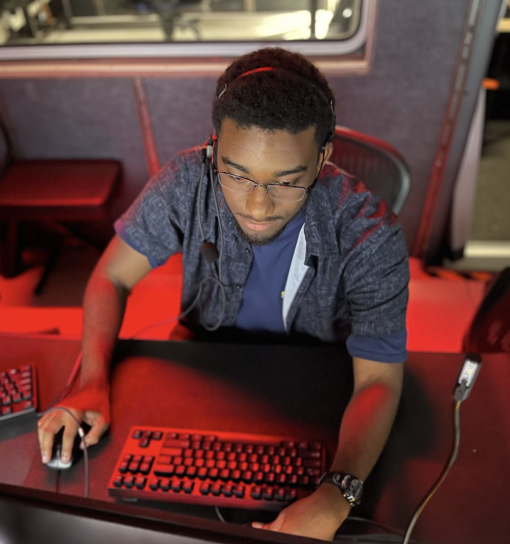
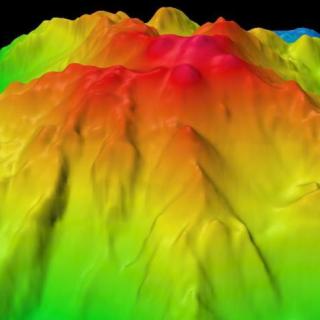
Johnston Atoll Mapping
This 24-day expedition will involve multibeam and sub-bottom profiler mapping to reveal the seafloor within the Johnston Atoll Unit of Pacific Remote Island Marine National Monument (PRIMNM). Johnston Atoll, one of the most isolated atolls globally, is located in the central Pacific Ocean, between the Hawaiian Islands and the Line Islands. The main objective of this expedition will be to collect high-resolution seafloor bathymetry data where it has not been previously collected.
